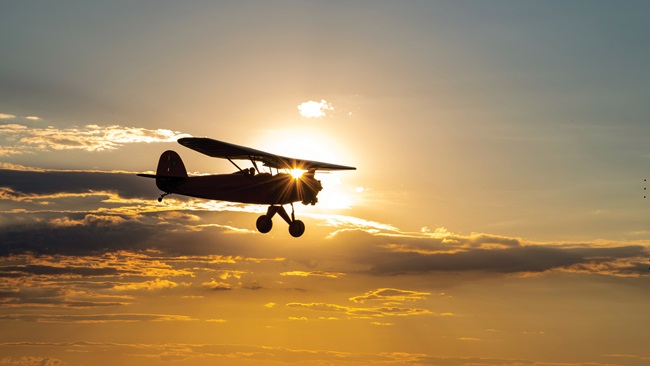Used Skyhawks a hot item
Industry insiders credit a strong economy and medical reform among the key factors driving one of the hottest used airplane markets many have seen in years.
Prices for 40-year-old airplanes do not typically jump 20 percent in the space of a few months, but that’s exactly what’s happened to Cessna Skyhawks produced between 1968 and 1976. Values for many other popular models, including newer aircraft, are also climbing fast.
Rodney Martz, a senior aviation technical specialist in AOPA’s Pilot Information Center, said the recent jump in sale prices for Skyhawks produced in the 1960s and 1970s stands out as the largest percentage increase he has seen in many years, if ever. AOPA monitors the market, and provides detailed information to members on request, through the Vref aircraft value reference service, which updates prices for used aircraft quarterly based on sales data reported by dealers. (For anyone in the market for an airplane, this is part of a suite of benefits that make an AOPA membership pay for itself, and then some.)
The AOPA Pilot Information Center staff routinely researches particular aircraft models and market activity on behalf of members.
“We talk to members every day,” Martz said. Through many years of service, Martz has never seen such a sharp increase in price for used aircraft models as the $6,000 to $10,000 increase in the price of used Skyhawks produced between 1968 and 1976 shown in the latest quarterly reports. Vref now lists retail prices up to $51,000 for a 1973 Cessna 172M with a mid-time engine, a 24-percent increase since the previous quarterly report.
“That’s the sharpest change I’ve witnessed,” Martz said. “We observed that indeed airplanes were selling for more than asking price, and they were selling in two days.”
Brenda Tibbs operates Bravo Flight Training at Frederick Municipal Airport in Frederick, Maryland (and was voted the Best Flight Instructor in AOPA’s 2016 Flight Training Excellence Awards). She said many of her students are eyeing aircraft purchases and struggling to move fast enough when they see an airplane they want.
“The people that I know that have been shopping for planes, they kind of have to buy them quickly or they just get scooped up,” Tibbs said, adding that the hot demand extends to Cessna 150 models as well: “They were gone just as fast as you could ask about them.”
Prices for many other aircraft of various vintages are also climbing, though not yet to the same degree as those older Skyhawks in percentage terms. Vref data shows Piper Cherokees and Warriors produced through 1980 are rising in price by about $1,000 over the past quarter; Archers are up between $1,000 and $5,000; prices for Arrows have risen up to $5,000 for certain models. Beechcraft Bonanzas are also seeing an uptick: “All A36s, everyone, is up $5,000,” Martz said.
Aviation analyst Brian Foley of Brian Foley Associates said the sharp increase in used piston prices stands out as a significant surprise. He said the strength of the U.S. stock market, gross domestic product growth (recently revised to 4.2 percent), and rising consumer confidence are probably among the factors driving “a nice churn of inventory on the lower end, there. Usually, when there’s an updraft like that, it can’t be explained by one reason.”
New aircraft deliveries have also shown strength in the piston market, including Piper’s recent, notable success selling to both domestic and foreign flight training providers who are working to produce pilots to address the shortage that is now being reported by many airlines.
That increased demand for professional pilots is driving much of the new business at Flight Training Professionals in Orlando, Florida, where co-owner Keith Wynsma said the laws of supply and demand are affecting newer aircraft, too.
“We use the G1000 aircraft in our flight school. That’s what we’ve been looking for,” Wynsma said, adding they’ve been “extremely difficult to find.”
To pick one recent example, Wynsma said a 2010 Cessna 172 recently came on the market at 8 a.m. and was sold by noon—for the $319,000 asking price. Not long ago, he said, that airplane would have been expected to sell for $270,000 or $280,000. “Having it go that high is just kind of ridiculous.”
Wynsma said that production of new airplanes is lagging behind demand, particularly in Florida, where hurricanes have destroyed many aircraft in recent years, and large flight schools are struggling to keep pace with the demand for flight training spurred by rapidly increasing airline salaries.
“Every flight school right now is pretty much running at the max,” Wynsma said. “We’ve got a waiting list.”
Wynsma said BasicMed is also helping to bring new pilots back into the fold, along with the AOPA Rusty Pilots program.
“We have a number of people who have not flown in years that are looking to get back into it,” Wynsma said. His school recently found three used Skyhawks to add to their fleet, 2014 models that should help whittle down that waiting list. As many as three out of every four students are now aiming for professional flying careers, and that’s another shift, Wynsma said, from a business that began marketing primarily to business professionals looking to cut their travel times and increase productivity.
The National Business Aviation Association released its annual compensation survey this month, reporting salary increases averaging up to 4 percent for all positions, including a 12-percent increase in pay for senior captains, up to $164,000. Foley said that is at least partly a reflection of wage growth across the broader employment market finally beginning to kick in after years of low unemployment but stagnant wage growth. “It really just mirrors what we’re seeing throughout multiple different industries.”
Foley said many foreign stock markets, notably China’s, are struggling, and that could spell trouble for the higher end of the airplane market in the future, along with another trend that particularly affects turbine aircraft. Foley noted that while business jet activity has increased, slowly but steadily since the economic crisis of 2008, utilization of jets in service has actually declined.
“After 10 years there have been some shifts in the business jet market… it seems more of the users of business jets are younger, tech background, Silicon Valley, that sort of thing,” Foley said. “The new generation coming into the market… they just want it when they need it, they don’t want to fuss with owning the thing. Going forward, that could hinder the sales of business jets.”
The mixed news and indicators on the higher end of the airplane market make it more tempting to look to BasicMed, which was implemented in 2017 and creates an alternative to medical certification for many general aviation pilots, as a key factor. Medical reform removed some of the uncertainty surrounding an individual pilot’s ability to maintain medical qualification along with reducing cost.
Helen Woods, owner and flight instructor at Chesapeake Sport Pilot in Stevensville, Maryland, said BasicMed and Rusty Pilots programs are helping to push airplane prices and demand, but she believes the economy is still the main driver.
“It’s the gorilla in the room,” Woods said, noting that EAA AirVenture in Oshkosh, Wisconsin, has drawn record crowds for two years running. She purchased a pair of Skyhawks for her own flight line last winter, and would have had a banner year except for a long run of lousy weather.
“People are spending on aviation right now,” Woods said. “What is moving right now is Cessnas that have IFR GPSs, (Garmin) 430 or later… if you can get a 180 (horsepower) conversion in there that has a 430 or better, they’re just being snatched up like hotcakes.”
Woods has seen such aircraft sell for $30,000 above appraised value, in a day or less. “The economy’s going right now.”
Tibbs and Wynsma both agreed that BasicMed is a factor for a significant number of their students, along with the Rusty Pilots program that also makes it easier to get back in the cockpit.
“I’ve got one guy right now, 23 years he hasn’t flown,” Wynsma said. “I think as it goes on you’re going to see more and more people.”
Lapsed pilots returning to active status may well be in the market for airplanes, and Martz noted that a good, used Skyhawk has always been a pretty good deal.




